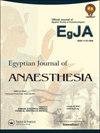Evaluating the perioperative analgesic effect of ultrasound-guided trigeminal nerve block in adult patients undergoing maxillofacial surgery under general anesthesia: A randomized controlled study
IF 0.5
Q3 ANESTHESIOLOGY
引用次数: 0
Abstract
ABSTRACT Background Although ultrasound-guided nerve blocks have lately been used to control pain, there is not much evidence assessing the outcome of trigeminal nerve block (TNB) in maxillofacial surgery. This study sought to evaluate the safety and efficacy of analgesia with an ultrasound-guided trigeminal nerve block (USGTNB) in patients undergoing unilateral maxillofacial surgery under general anesthesia. Methods This single-blinded, parallel-group, randomized clinical trial included 50 adult patients who had American Society of Anesthesiologists physical status I or II and were prepared for elective unilateral maxillofacial procedure under general anesthesia. The patients were randomized into two groups. In the intervention (TNB) group, 25 patients received USGTNB using 5 ml of bupivacaine 0.25%, while in the control group, 25 patients received only general anesthesia. Total intraoperative fentanyl consumption was the primary outcome. The secondary outcomes were the intraoperative hemodynamic parameters besides the postoperative pain, total opioid consumption, complications, and patient satisfaction. Results Compared to general anesthesia, USGTNB significantly reduced the intraoperative fentanyl consumption (2.38 ± 0.62 vs 0.36 ± 0.55, p < 0.001), and the intraoperative heart rate and mean arterial blood pressure at 1, 2, and 3 h (p < 0.001), the numerical rating score during the 24 postoperative hours (p < 0.001), and the postoperative nalbuphine consumption (11.60 ± 4.72 vs 1.92 ± 3.28, p < 0.001). USGTNB had a better safety profile and showed better patient satisfaction compared to general anesthesia alone (8.04 ± 0.89 vs 5.84 ± 0.90, p < 0.001). Conclusion USGTNB can provide an effective, safe approach for controlling pain in adult patients undergoing maxillofacial surgery.超声引导下三叉神经阻滞在成人全麻颌面外科手术患者围手术期镇痛效果评价:一项随机对照研究
本文章由计算机程序翻译,如有差异,请以英文原文为准。
求助全文
约1分钟内获得全文
求助全文
来源期刊

Egyptian Journal of Anaesthesia
Medicine-Anesthesiology and Pain Medicine
CiteScore
0.90
自引率
0.00%
发文量
78
 求助内容:
求助内容: 应助结果提醒方式:
应助结果提醒方式:


